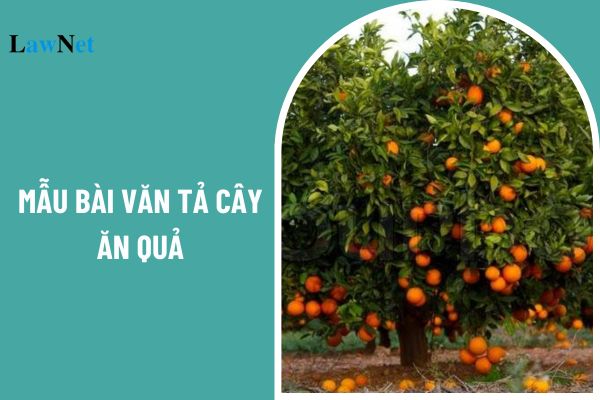What are the 02 sample descriptive essays on fruit trees for 4th-grade students in Vietnam? What are the assessment criteria for 4th-grade students in Vietnam?
What are the 02 sample descriptive essays on fruit trees for 4th-grade students in Vietnam?
Below are 02 sample descriptive essays on fruit trees for 4th-grade students in Vietnam:
Description of the Orange Tree in My Garden
| The orange tree in my garden always makes me feel peaceful every time I see it. It is a long-standing orange tree with a rough bark, dark brown color, covered in moss. Although the tree has grown tall, its trunk still retains resilience, standing steadfast like a soldier guarding the homeland soil. The branches stretch out, creating a large shade for the garden. Each season, the orange tree dons a different appearance, full of vitality. In the spring, the orange tree begins to sprout and grow fresh green leaves as if they were just covered in a layer of morning dew. The branches also start to appear with tiny, pure white orange blossoms, emitting a gentle fragrance. Whenever there's a gentle breeze, the orange petals flutter, creating a poetic scene, like a colorful painting. When summer comes, the oranges begin to ripen on the branches, their peel initially lush green, gradually turning to a bright, shiny yellow. The oranges are large, plump, with taut skin, and when touched, they have a slight elasticity, as if ready to offer us a sweet portion. Each heavy orange on the branch makes the tree even more laden with fruit, like a gift that nature has bestowed upon humans. When you cut open an orange, you will see a thin, smooth peel that is easy to remove, revealing the golden, juicy segments inside. The taste of the orange is mildly sweet, not too sour, cool, and fragrant, making everyone delighted when enjoying it. Each time I eat an orange, I feel the sweet taste of the earth and sky, the care of my grandmother, and the hard work of the farmers. The orange tree in the garden is not just a fruit tree but also a part of childhood memories tied to joyful summer days. It is always a symbol of family reunion, a precious gift that nature has bestowed on my homeland. |
| --- |
Description of the Guava Tree in the Garden
| In my garden, the guava tree is one of the special fruit trees closely tied to my childhood. This guava tree has been around for a very long time, its height just enough to provide shade for the garden on hot summer days. The tree's trunk is rough, dark brown, with scars of time creating unforgettable marks. The branches stretch out wide like a natural roof sheltering the flowers and grass growing beneath. The guava leaves are dark green, large, and thick, sometimes slightly wrinkled as if they have endured many rains, yet they still retain their freshness. In spring, the guava tree blooms with pure white, tiny flowers that emit a gentle, captivating fragrance that attracts passersby. The fragile guava petals are surrounded by radiant yellow stamens, resembling twinkling stars under the morning sun. When summer arrives, the guava tree starts bearing fruit. The small guavas initially have a pale green color, but soon they turn to a light yellow, become round and plump. Each fruit has a rough surface, slightly coarse, but concealed inside are sweet, crispy guava segments. When you cut the guava, a pleasant fragrance immediately fills the air, soothing those around. This scent is unique, quite different from any other fruits in the garden. When enjoying the guavas from the tree in the garden, I always sense the mild sweetness and coolness spreading in my mouth. Each time I eat guava, I not only feel the deliciousness of the fruit but also feel enveloped in the peaceful atmosphere of my homeland. The guava tree is not only a valuable food source but also a part of my memories, a symbol of simplicity, closeness, and filled with the love of family. The guava tree stands firmly there, diligently providing delicious guavas, reminding me of childhood days, of happy summers with my grandmother and family. |
Note: The information is for reference only!

What are the 02 sample descriptive essays on fruit trees for 4th-grade students in Vietnam? What are the assessment criteria for 4th-grade students in Vietnam? (Image from Internet)
What are the required outcomes regarding writing practice for 4th-grade students in Vietnam?
- Write a narrative essay recounting an event witnessed (seen or watched) or participated in and share thoughts and feelings about it.
- Write an essay retelling a story read or heard, or write an imaginary paragraph based on a story read or heard.
- Write a descriptive essay about animals or plants; use personification and words that highlight the distinguishing features of the subject being described.
- Write a paragraph expressing personal feelings about a character in literature or a person close and dear.
- Write a short paragraph explaining why you like a story that has been read or heard.
- Write a short text guiding the steps to perform a task or use a product, consisting of 2-3 steps.
- Write a group discussion report, follow a form, or write a letter to family or friends.
What are the assessment criteria for 4th-grade students in Vietnam?
The assessment criteria for 4th-grade students are specified in section 1, Article 5 of the Regulations on Primary School Student Assessment issued with Circular 27/2020/TT-BGDDT:
1) Assess learning process, progression and academic results of students satisfying requirements and specific display of capacities of each subject and academic activities according to formal primary education programs.
2) Assess formation and development of traits and capacities of students via the following primary traits and capacities:
- Primary traits: patriotism, humane, diligence, honesty, and sense of responsibility.
- Primary capacities:
+) General capacities: self-control, self-studying, communication, cooperation, problem resolution and creativity;
+) Specific capacities: language, calculation, science, technology, computer, aesthetic, and physical attributes.

